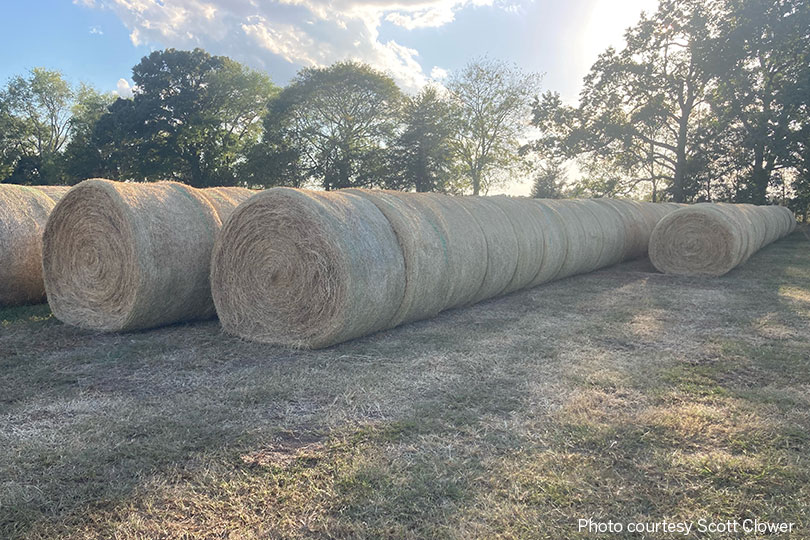By Tom Nicolette
Senior Network Producer
Hay production in Texas is down significantly due to the ongoing drought conditions.
Scott Clower raises beef cattle and grows hay in Gregg and Rusk counties in Northeast Texas. This year has been a challenge for him.
“We have averaged on our fields only two cuttings this year. The first cutting was about a third of our normal cutting. The August rains here in our part of the state really took our hay off in August,” Clower said in an interview with Texas Farm Bureau Radio Network. “Seems everyone here has gotten one really good cutting, above average of what is normal this time of year, which has kind of saved most producers here.”
But the hay quality is acceptable.
“It’s been really good. I know some people had not fertilized. I was able to fertilize, so I have some really good hay,” he said. “But I think everyone was looking for more tonnage than quality, so I would say it’s just a tonnage factor for everyone here, not so much the quality.”
Clower, who is also the Gregg County Farm Bureau secretary, said he still has about 100 acres of hay to harvest. It’s not fertilized but “just something I’m baling for an emergency, so it’s going to be about a third of a normal cutting.”
The decreased supply and increased demand for hay is driving up the price.
“I see prices anywhere from $100 to $125 (per bale) in this part of the state for good coastal fertilized. Just depends on where you are, who has it and how much they have,” he said. “But I’m going to say around $100 to $110 is going to be the price for good hay.”
The region hasn’t seen rain since August.
“Well, grazing conditions are still pretty good,” Clower said. “We haven’t had a significant rain here now in over a month. It’s getting really dry, so we’re fading quickly.”
Clower noted he should be able to hold out with his pasture conditions another three to four weeks before feeding hay. He said some people may have to start feeding within the next two to three weeks depending on the weather.
“The rains were just perfect in August. The weather was ideal, and it was a boon hay crop at the perfect time for everyone to just catch up. I don’t think there’s a lot of extra hay here, but I think everybody’s just on the border of having enough, just on that edge, that fine line. I’m in good shape I think, so crossing my fingers,” Clower said.
With the Texas winter forecast still indicating drier and warmer than normal conditions due to the La Nina weather pattern, Clower has decided to try something new this year.
“One of the things I’m going to try is we’re going to plant winter pasture. I have a pasture that we irrigate and raise hay in, so I’m going to put in a winter pasture and go ahead and start irrigating and getting that crop growing,” he said. “I’ll have some green forage for my cattle to graze on to try to extend my hay and make it to the spring. That’s going to be my main plan besides haying and cubes.”
He’s hopeful, despite the tough times farmers and ranchers have experienced this year.
”(These are) desperate times. We’re going to see what we can come up with and give it a shot. There may be something we expand on in the future,” Clower said.

